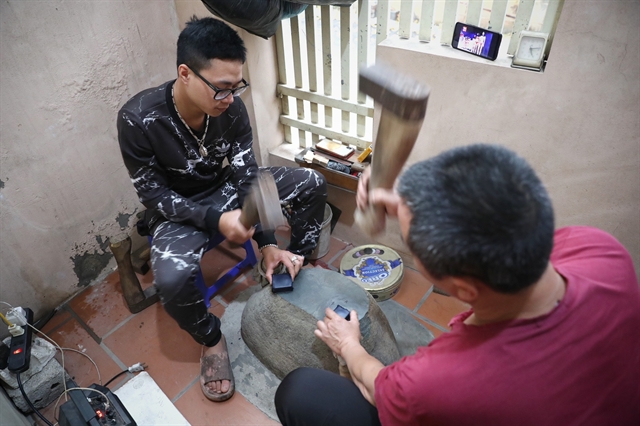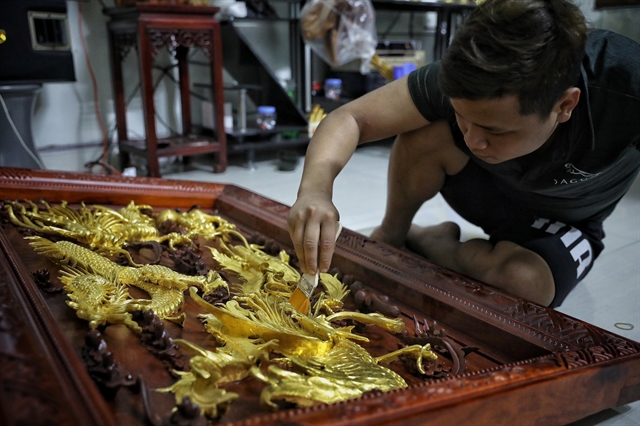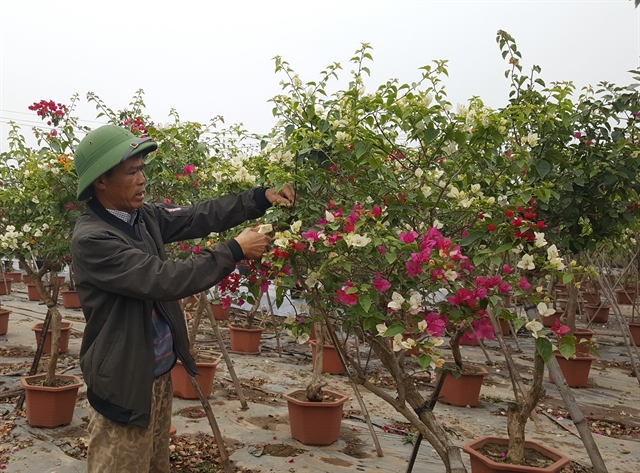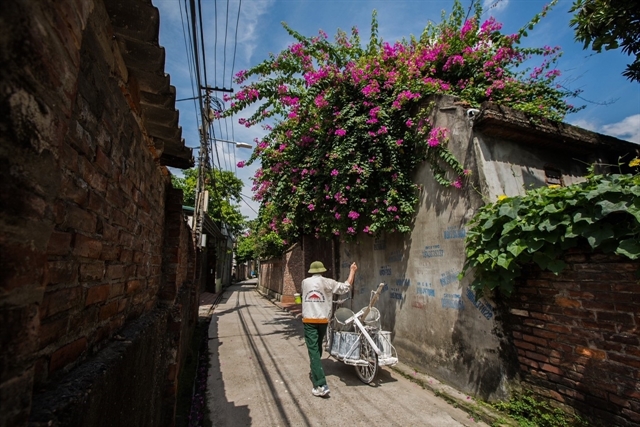 Society
Society

 |
| Labourers at Kiêu Kỵ Gold Laminating and Gilding Craft Village in Gia Lâm District, Hà Nội.— Photo courtesy of the New Rural Development Programme’s Coordination Office in Hà Nội |
HÀ NỘI — Gia Lâm District, located at the gateway to the east of Hà Nội, has developed new tourism practices involving agriculture and craft villages. This is thanks to the area's strong tradition of craft villages converging from generation to generation as well as its proximity to the beautiful landscapes along the Hồng (Red) River and Đuống River.
Nguyễn Xuân Hùng, Chairman of the Board of Directors of Hiệp Thư Agricultural Development and Commercial Service Cooperative, said that while following the National Target Programme on building new-style rural areas in the district, the cooperative has also deployed tourism services in agricultural production and environment by investing in the construction of Phù Đổng Green Park - an ecological zone with a scale of 15.6 ha in Phù Đổng Commune.
Initially, the cooperative only wanted to deploy a project to treat waste from cows by raising earthworms to protect the environment, he said.
"The cooperative realised the area has many advantages to develop models of agricultural tourism and provide experiences for students, so we built Phù Đổng Green Park," he said.
 |
| Nguyễn Văn Hiệp makes a wooden ornament in Kiêu Kỵ Gold Laminating and Gilding Craft Village in Gia Lâm District, Hà Nội.— Photo courtesy of the New Rural Development Programme’s Coordination Office in Hà Nội |
Trần Xuân Tĩnh, Chairman of the People's Committee of Phù Đổng Commune, said the project on developing agricultural production under specialised agricultural areas in the commune has led to it converting dozens of hectares of inefficient rice fields to planting fruit trees, flowers, ornamental plants, gardens and ponds.
The commune has also grown an eggplant garden associated with the legend of Saint Gióng and a vegetable production area in Đổng Viên Village, he said.
Saint Gióng, one of Việt Nam's four 'immortal heroes,' was a little boy from Hà Nội's Phù Đổng Village who helped bring peace to the country by defeating the Ân invaders in the 6th Hùng King Dynasty. According to legend, Saint Gióng's mother put her feet on God's footsteps in an eggplant garden and then gave birth to Saint Gióng.
 |
| A farmer takes care of his paper flowers in Phù Đổng Commune in Gia Lâm District. The commune has become a hot spot for tourists thanks to the development of agricultural tourism.— Photo courtesy of the New Rural Development Programme’s Coordination Office in Hà Nội |
In Bát Tràng Commune, already famous for its Ceramic Village, the Chairman of the People's Committee said since 2020, they have operated tourism products such as a cycling tour from the inner city to the commune and a tour connecting it several destinations from Hưng Yên Province.
Cycling tours have voice narration in Vietnamese and English for tourists. The tour is very popular among foreign tourists currently, he said.
In addition, the commune has continued to decorate local streets, calling on households to design beautiful shops with flowers creating a green and clean landscape for tourists, he added.
It is estimated that the commune welcomes about 3,000-5,000 tourists every weekend thanks to the development of activities in the area, he said.
Phùng Thị Hoài Hương, Head of the district’s Culture and Information Office said it has great potential to develop more agriculture and craft villages which will subsequently further boost tourism.
The district will continue to develop key tourism products, which will focus on three key areas, she said.
 |
| A rural road in Bát Tràng Ceramic Village, Bát Tràng Commune, Gia Lâm District in Hà Nội.— Photo courtesy of the New Rural Development Programme’s Coordination Office in Hà Nội |
The three areas consist of the Hồng (Red) River area with tourist attractions including Kim Lan Ceramic Village, Bát Tràng Ceramic Village and Văn Đức agricultural experience; the area around the Đuống River with spiritual and cultural tourism at Nguyên Phi Ỷ Lan Temple, and the home of the poet Cao Bá Quát in Phú Thị Commune. There's also a manmade beach in the Ocean Park gated community, riverside experiences in Kim Sơn Commune; and the Saint Gióng Temple and Ninh Hiệp traditional medicine village.
Tạ Văn Tường, Deputy Director of the city’s Agriculture and Rural Development Department, said that the growth of agriculture and craft villages is a new direction that is improving the income of people in rural areas, as well as developing the rural economy.
 |
| A foreign tourist visits a shop in Bát Tràng Ceramic Village in Gia Lâm District in Hà Nội.— Photo courtesy of the New-style Rural Development Programme’s Coordination Office in Hà Nội |
Nguyễn Văn Chí, Deputy Chief of the New Rural Development Programme’s Coordination Office in Hà Nội, said that developing agriculture and craft villages in association with tourism is now popular with many localities, including Gia Lâm district.
The operation of agricultural tourism, craft villages, and educational experiences boosts the cultural value of each locality has gradually created more jobs and brought stable incomes for people in rural areas, he said.
In Gia Lâm district, preserving and promoting the value of traditional craft villages is given significant attention by local administration, he said.
Traditional craft villages such as Kiêu Kỵ Gold Laminating and Gilding Craft Village, Kim Lan Ceramic Village, and Bát Tràng Ceramic Village have generated value and ensured sustainable tourism development, he said.
From positive innovations in the development of agriculture and craft villages, the district is expected to become an attractive destination for domestic and foreign tourists.
The article is published with coordination of the Coordination Office of the New-Style Rural Development Programme in Hà Nội. — VNS




